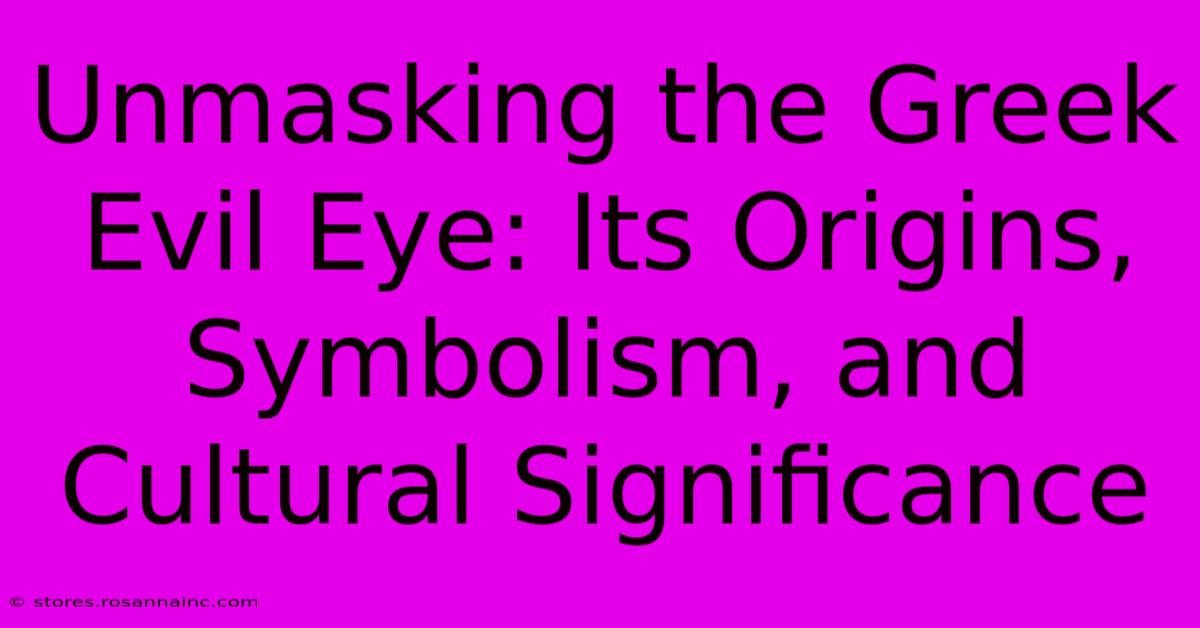Unmasking The Greek Evil Eye: Its Origins, Symbolism, And Cultural Significance

Table of Contents
Unmasking the Greek Evil Eye: Origins, Symbolism, and Cultural Significance
The "mati," or evil eye, is more than just a pretty trinket; it's a potent symbol deeply woven into the fabric of Greek culture and history. For centuries, it has represented both a feared threat and a powerful amulet against malevolence. This article delves into the origins, symbolism, and enduring cultural significance of this fascinating emblem.
The Origins of the Evil Eye: A Look into History
The concept of the evil eye – the belief that someone can inflict harm or misfortune through their envious gaze – is ancient, transcending geographical boundaries and cultures. While its precise origins remain shrouded in mystery, evidence suggests its presence in various ancient civilizations, including those of Mesopotamia, Egypt, and Rome. However, the Greek evil eye, with its distinctive blue and white design, holds a unique place in history.
Its origins in Greece are entwined with folklore and mythology. Ancient Greeks believed that the power of the evil eye stemmed from intense, negative energy projected unintentionally, often through envy or admiration. This belief wasn't limited to the superstitious; even prominent figures likely held similar convictions. The fear of the "mati" wasn't about deliberate malice but rather the unconscious, negative energy emanating from a powerful gaze.
Early Representations and Beliefs
Early depictions of the evil eye are scarce, but its impact is undeniable. The belief in its power influenced daily life, leading to protective measures and rituals. This early manifestation laid the groundwork for the elaborate traditions and amulets seen today. Understanding the historical context allows for a deeper appreciation of the symbol's continued relevance.
Symbolism and Iconography of the Greek Evil Eye
The Greek evil eye, typically a small, blue glass amulet (though other colors exist), is often characterized by its concentric circles. These circles represent the eye itself, radiating outwards to ward off negative energy.
The Power of the Blue Color
The prevalence of blue is particularly significant. In Greek culture, blue often symbolizes protection and the divine. It's believed to deflect negativity and absorb the harmful energy projected by the evil eye.
Variations in Design and Meaning
While the classic blue amulet is most common, variations exist. The number of circles, the addition of other colors, or intricate designs can subtly alter the perceived power or intended use of the amulet. These differences often reflect regional variations or personal beliefs.
The Cultural Significance: Protecting Against the Mati
The Greek evil eye is far more than just a piece of jewelry; it's a deeply ingrained part of Greek culture, actively used to protect against misfortune and bad luck.
Everyday Use and Traditions
From homes and businesses to cars and clothing, the evil eye is ubiquitous. It’s a constant reminder of the potential for negative energy and a symbol of protection against it. Giving the evil eye as a gift is a common practice, conveying good wishes and safeguarding the recipient from ill will.
Modern Interpretations and Adaptations
While its traditional significance endures, the evil eye has seen a resurgence in popularity, transcending its cultural roots. It's become a trendy fashion accessory worldwide, yet its symbolic power remains potent for those who understand its origins and meaning.
Conclusion: A Legacy of Protection
The Greek evil eye is a powerful symbol with rich historical roots and enduring cultural significance. Its enduring popularity speaks volumes about its perceived efficacy and its deep connection to Greek identity and traditions. Whether worn as a charm or displayed as a decorative item, the mati's ability to inspire a sense of protection and ward off negativity continues to resonate across generations. It remains a tangible expression of a belief system that has stood the test of time.
Keywords: Greek evil eye, mati, evil eye, Greek culture, Greek traditions, symbolism, protection, amulet, charm, folklore, mythology, blue eye, origins, history, cultural significance, bad luck, envy, negative energy, concentric circles, Greek beliefs, protective amulet, traditional customs.

Thank you for visiting our website wich cover about Unmasking The Greek Evil Eye: Its Origins, Symbolism, And Cultural Significance. We hope the information provided has been useful to you. Feel free to contact us if you have any questions or need further assistance. See you next time and dont miss to bookmark.
Featured Posts
-
No Mas Imagenes Contenidas Descubre El Software Magico Para Eliminar Texto
Feb 06, 2025
-
Unlock The Secrets Of 50 South Fourth Street Unveiling A Hidden Haven In Henderson Nv
Feb 06, 2025
-
Divine Worship A Guide To Honoring The Sacred With Purpose And Passion
Feb 06, 2025
-
Pom Pom Power Unleash The Joy Of Creating Your Own Fluffy Masterpieces
Feb 06, 2025
-
Say Goodbye To Buffering C Fexpress Type A Rescues Lagging Cameras
Feb 06, 2025
